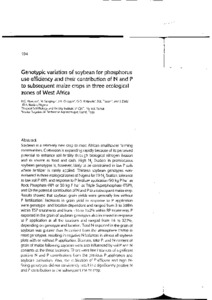| dc.contributor.author | Abaidoo, R.C. |
| dc.contributor.author | Sanginga, Nteranya |
| dc.contributor.author | Okogun, J.A. |
| dc.contributor.author | Kolawole, G.O. |
| dc.contributor.author | Tossah, B.K. |
| dc.contributor.author | Diels, J. |
| dc.date.accessioned | 2019-12-04T11:18:12Z |
| dc.date.available | 2019-12-04T11:18:12Z |
| dc.date.issued | 2007 |
| dc.identifier.citation | Abaidoo, R.C., Sanginga, N., Okogun, J.A., Kolawole, G.O., Tossah, B.K. & Diels, J. (2007). Genotypic variation of soybean for phosphorus use efficiency and their contribution of N and P to subsequent maize crops in three ecological zones of West Africa, Demand-driven technologies for sustainable maize production in West and Central Africa: Proceedings of the fifth Biennial West and Central Africa Regional Maize Workshop, Cotonou, (p. 194-224), 3-6 May, 2005. Ibadan: IITA. |
| dc.identifier.uri | https://hdl.handle.net/20.500.12478/3101 |
| dc.description.abstract | Soybean is a relatively new crop to most African smallholder farming communities. Cultivation is expanding rapidly because of its perceived potential to enhance soil fertility through biological nitrogen fixation and its source as food and cash. High N2, fixation in promiscuous soybean genotypes is, however, likely to be constrained in low P soils where fertilizer is rarely applied. Thirteen soybean genotypes were evaluated in three ecological zones of Nigeria for (1) N2, fixation, tolerance to low soil P (0P), and response to P fertilizer application (90 kg P ha' as Rock Phosphate (RP) or 30 kg P ha' as Triple Superphosphate (TSP), and (2) the potential contribution of N and P to a subsequent maize crop. Results showed that soybean grain yields were generally low without P fertilization. Increases in grain yield in response to P application were genotype- and location-dependent and ranged from 3 to 308%within TSP treatments and from -1 6 to 1520/o within RP treatments. P exported in the grain of soybean genotypes also increased in response to P application at all the locations and ranged from 1 6 to 3270/0, depending on genotype and location. Total N exported in the grain of soybean was greater than N derived from the atmosphere (Ndfa) in most genotypes, resulting in negative N balances in almost all soybean plots with or without P application. Biomass, total P, and N content of grain of maize following soybean were also influenced by soil P and N contents at the three locations. There were few instances of significant positive N and P contributions from the previous P, application and soybean cultivation. Also, the cultivation of P-efficient and high N-fixing genotypes did not consistently result in a significantly positive N and P contribution to the subsequent maize crop. |
| dc.description.abstract | Le soia qui est relativement une nou,relle spdculation pour la plupartdes communautes des petits expioitants d'Afrique, se d6velopperapidernent il cause de son potentiel connu d'augmentation de lafertilit€ des sols par la fixation biologique d'azote, dans l'alimentationet comme culture de rente. La fixation €levee en N, des genotypesde soia promiscues, est cependant, probablement restreinte dansles sols pauvres en P ou l'engrais est rarement appliqu€. Treizegenotypes de soia ont 6t6 6valu6s dans trois zones 6cologiques duNig6ria pour (1) la fixation de Nr, la tol6rance aux sols pauvres enP (0P), et la r€ponse i l'application d'engrais riche en P (90 kg Pha-r comme Phosphate naturel (Pil ou 30 kg P hal comme TripleSuperphosphate (TSP), et (2) pour leur contribution potentielle de N etP i une culture subsequente de mais. Les rendements grains de soia6taient g6n6ralement faibles sans fertilisation de P' Les'genotypes desoia variaient dans leurs rdponses en fonction de la fertilisation en P.Les accroissements de rendements grains en r6ponse i la fertilisationde P ftaient dependants des genotypes et de la localit€ et variaientde 3 d 308o/o dans les traitements TPS et de -16 a 1520/o dans lestraiternents PR. Le P export6 cians ie grain des genorypes de soiaa aussi augmente en r6ponse i l'application de TSP dans toutes leslocalites et variait de 16 a 3270/o en fonction des genotypes, la sourcede P et la localit6. l-'azote N total export6 dans le grain des genotypesde soia 6tait toujogrs plus elev6 que l'N d6riv€ de l'atmosphdre (Ndfa)dans la plupart des g,6notypes' Ceia a aboutlt en des bilans n6gatifsdans presque toutes les parcelles de soia avec ou sans applicationde P. La biomasse, le P total et N contenu dans le grain du maiscons6cutifs aux genotypes de soia ont 6t€ aussi influenc6s par les lateneur du sol en P et N dans les"trois localit6s et dtaient caract6risespar quelques exemples de contributlons significatives et positives de Net P, de pr6c6dentes application de P et de culture de soia. La culturede g6notypes efficaces dans l'utilisation de P et dans la fixation de Nn'a pas 169ulidrement aboutit i la contribution significative et positivede N et P d la culture subsdquente de majs. |
| dc.language.iso | en |
| dc.language.iso | fr |
| dc.subject | Soybeans |
| dc.subject | Genotypes |
| dc.subject | Soil Fertility |
| dc.subject | Maize |
| dc.subject | Nutrition |
| dc.title | Genotypic variation of soybean for phosphorus use efficiency and their contribution of N and P to subsequent maize crops in three ecological zones of West Africa |
| dc.type | Conference Paper |
| dc.description.version | Peer Review |
| cg.contributor.affiliation | International Institute of Tropical Agriculture |
| cg.contributor.affiliation | International Center for Tropical Agriculture |
| cg.contributor.affiliation | lnstitut Togolais de Recherche Agronomique |
| cg.coverage.region | Africa |
| cg.coverage.region | West Africa |
| cg.coverage.country | Togo |
| cg.coverage.country | Nigeria |
| cg.authorship.types | CGIAR and developing country institute |
| cg.iitasubject | Soybean |
| cg.iitasubject | Maize |
| cg.iitasubject | Soil Fertility |
| cg.iitasubject | Genetic Improvement |
| cg.iitasubject | Nutrition |
| cg.accessibilitystatus | Limited Access |
| local.dspaceid | 94567 |

